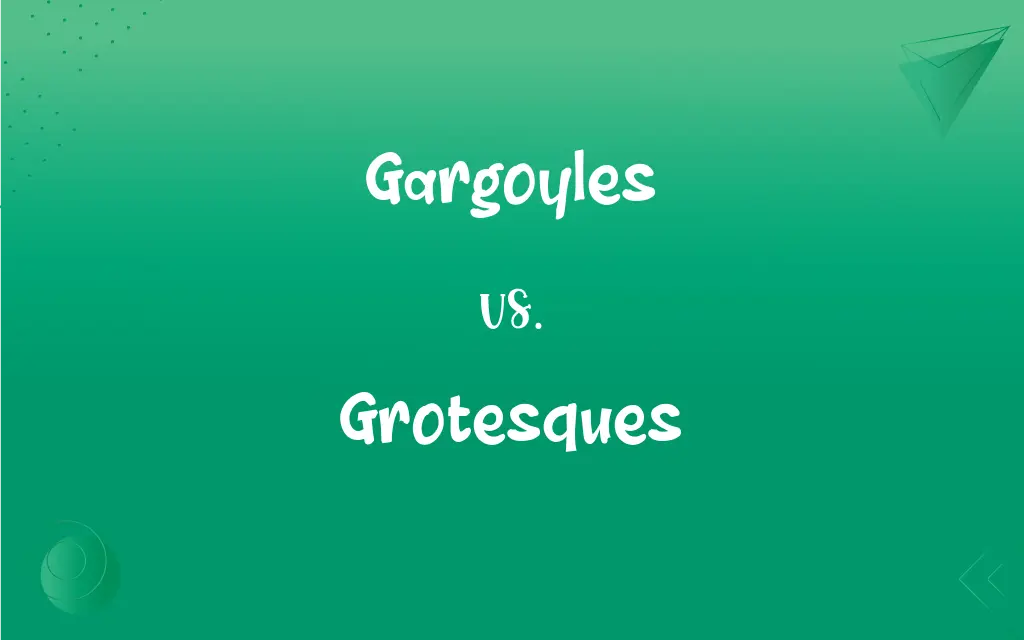Gargoyles vs. Grotesques: What's the Difference?
Edited by Aimie Carlson || By Janet White || Published on November 3, 2023
"Gargoyles" are carved, functional water spouts; "Grotesques" are decorative, monstrous carvings not used as spouts.

Key Differences
"Gargoyles" and "Grotesques," while both architectural elements, serve different purposes. "Gargoyles" are specifically designed as water spouts, engineered to divert rainwater from the sides of buildings, usually gothic cathedrals. "Grotesques," on the other hand, are carved stone figures often used for decorative purposes, and while they may appear similar to gargoyles, they lack the functional aspect of diverting water.
"Gargoyles" often depict creatures or figures designed to scare off evil, while "Grotesques" are more varied in form, featuring humans, animals, or imaginary beings, sometimes in absurd or comically distorted postures. Both "Gargoyles" and "Grotesques" serve a symbolic function, often conveying moral lessons or reflecting beliefs of the period in which they were created.
The architectural significance of "Gargoyles" is tied to their functionality in preserving stone walls by preventing rainwater from running down the sides of a building. "Grotesques," while similar in appearance, are not designed to serve this purpose. Instead, they are often involved in the ornamental aspect, contributing to the aesthetic appeal of the structure.
"Gargoyles" are specifically associated with the Gothic architectural style, where they are a common feature. In contrast, "Grotesques" can be found in a variety of architectural styles, spanning different historical periods and are not confined to water spouts or the Gothic period.
Both "Gargoyles" and "Grotesques" have transcended their architectural origins to feature in modern culture. "Gargoyles" are often associated with the macabre or supernatural due to their eerie appearance and functional association with water, symbolizing purity against evil. "Grotesques," with their distorted and fantastical imagery, have inspired art, literature, and even psychology, as in the concept of the "grotesque body."
ADVERTISEMENT
Comparison Chart
Function
Water spouts to divert rainwater
Decorative, no water-diverting function
Depiction
Often monstrous, frightening
Varied, can be absurd or comical
Symbolism
Ward off evil, purity
Moral lessons, aesthetic appeal
Architectural Style
Primarily Gothic
Various styles
Cultural Significance
Associated with macabre, supernatural
Influence in art, literature, psychology
ADVERTISEMENT
Gargoyles and Grotesques Definitions
Gargoyles
Carved stone creatures, usually functioning as water spouts.
The medieval church is adorned with menacing gargoyles.
Grotesques
Architectural elements, symbolizing moral tales or lessons.
Grotesques in ancient structures often reflect the cultural ethos of the era.
Gargoyles
Architectural features designed to ward off evil.
Gargoyles were believed to protect against malevolent spirits.
Grotesques
Artistic representations of the absurd or unnatural.
The artist's use of grotesques challenged our perception of beauty.
Gargoyles
Grotesque carved figures associated with Gothic architecture.
Gargoyles are synonymous with the haunting appeal of Gothic buildings.
Grotesques
Carvings of humans, animals, or mythical creatures.
Grotesques on the historic building depicted a menagerie of fantastical beings.
Gargoyles
Stone figures symbolizing purity and safety.
Gargoyles, by directing water away, preserved the sanctity of holy structures.
Grotesques
Decorative stone carvings, often bizarre or distorted.
The manor's hall was lined with a variety of grotesques.
Gargoyles
Cultural symbols in literature and folklore.
In stories, gargoyles come to life, guarding treasures or secrets.
Grotesques
Influential symbols in various artistic genres.
Grotesques have a profound impact, from Renaissance art to modern horror.
Gargoyles
A roof spout usually in the form of a grotesque or fantastic creature projecting from a gutter to carry rainwater clear of the wall.
Grotesques
Characterized by ludicrous, repulsive, or incongruous distortion, as of appearance or manner.
Gargoyles
A grotesque ornamental figure or projection.
Grotesques
Outlandish or bizarre, as in character or appearance.
Gargoyles
A person of bizarre or grotesque appearance.
Grotesques
Of, relating to, or being the grotesque style in art or a work executed in this style.
Gargoyles
Plural of gargoyle
Grotesques
One that is grotesque.
Grotesques
A style of painting, sculpture, and ornamentation in which natural forms and monstrous figures are intertwined in bizarre or fanciful combinations.
Grotesques
A work of art executed in this style.
Grotesques
Plural of grotesque
FAQs
Can "Grotesques" be humorous?
Yes, they can be comically distorted.
What do "Grotesques" represent?
Can symbolize moral tales, lessons, or aesthetics.
Are "Gargoyles" considered art?
Yes, they're a form of sculptural art.
Are "Gargoyles" unique to Gothic architecture?
Primarily, but found in other styles too.
Do "Grotesques" appear in various architectural styles?
Yes, across various periods and styles.
Are "Gargoyles" functional architecture?
Yes, they serve as water spouts.
Are "Gargoyles" always scary?
Often, designed to ward off evil.
Do "Gargoyles" symbolize protection?
Traditionally, they ward off evil spirits.
Can "Grotesques" influence literature?
Yes, they've inspired various genres.
Do "Grotesques" have a water-diverting function?
No, they're purely decorative.
Are "Grotesques" found in secular buildings?
Yes, common in both religious and secular architecture.
Are "Grotesques" solely a Western concept?
Predominant in Western art, but similar concepts exist globally.
Are "Grotesques" linked to the concept of the absurd?
Often, they depict the unnatural or bizarre.
Do "Grotesques" reflect societal beliefs?
Often, they mirror cultural or moral values.
Are "Gargoyles" always made of stone?
Traditionally stone, but other materials can be used.
Do "Gargoyles" appear in pop culture?
Yes, in films, books, and more.
Do "Gargoyles" have religious significance?
Often associated with churches and spiritual protection.
Can "Gargoyles" be fantastical creatures?
Often depict monsters or mythical beings.
Do "Grotesques" involve human figures?
Can include humans, animals, or imaginary beings.
Can "Gargoyles" symbolize purity?
Water association connects them to purity.
About Author
Written by
Janet WhiteJanet White has been an esteemed writer and blogger for Difference Wiki. Holding a Master's degree in Science and Medical Journalism from the prestigious Boston University, she has consistently demonstrated her expertise and passion for her field. When she's not immersed in her work, Janet relishes her time exercising, delving into a good book, and cherishing moments with friends and family.
Edited by
Aimie CarlsonAimie Carlson, holding a master's degree in English literature, is a fervent English language enthusiast. She lends her writing talents to Difference Wiki, a prominent website that specializes in comparisons, offering readers insightful analyses that both captivate and inform.






































































